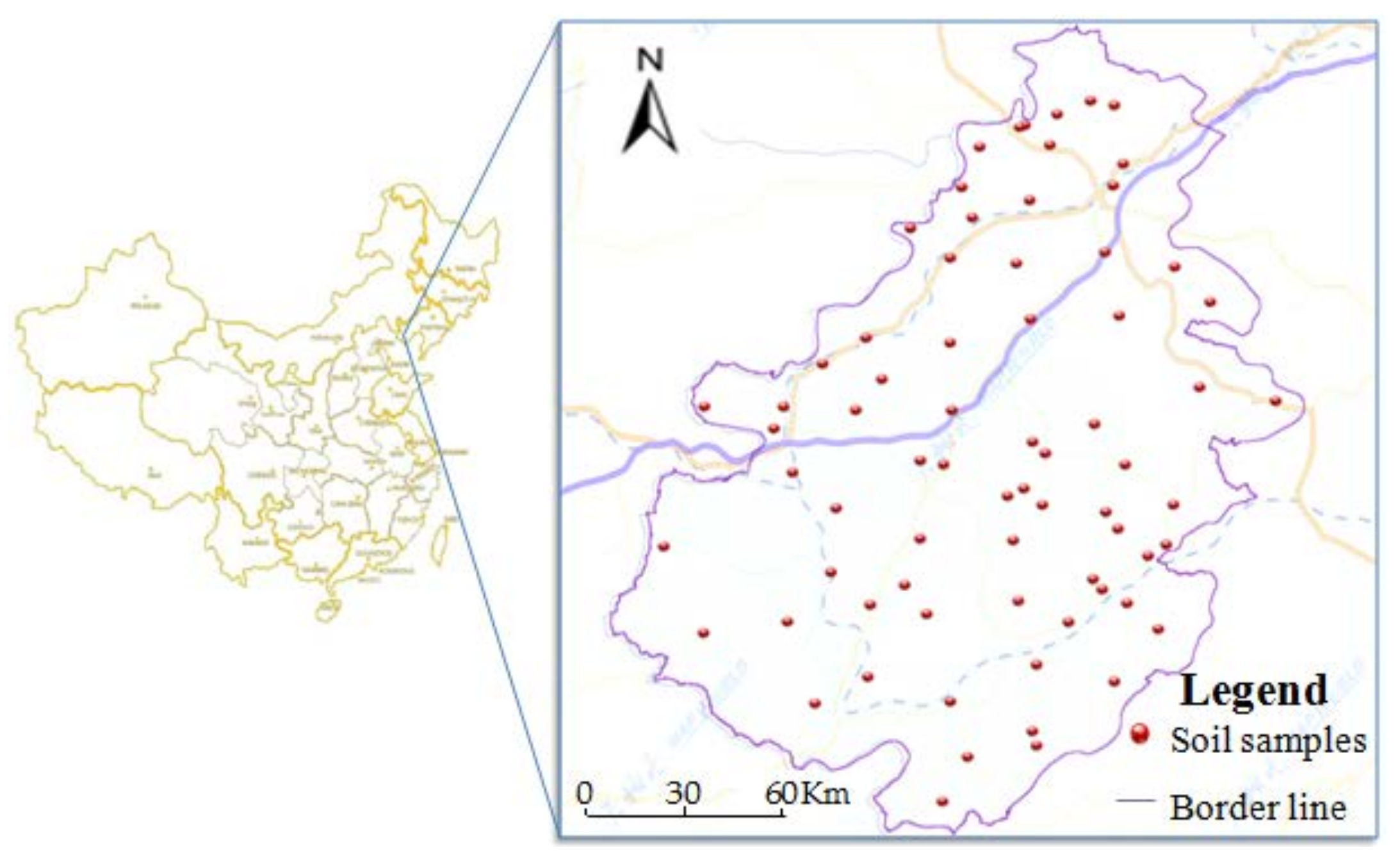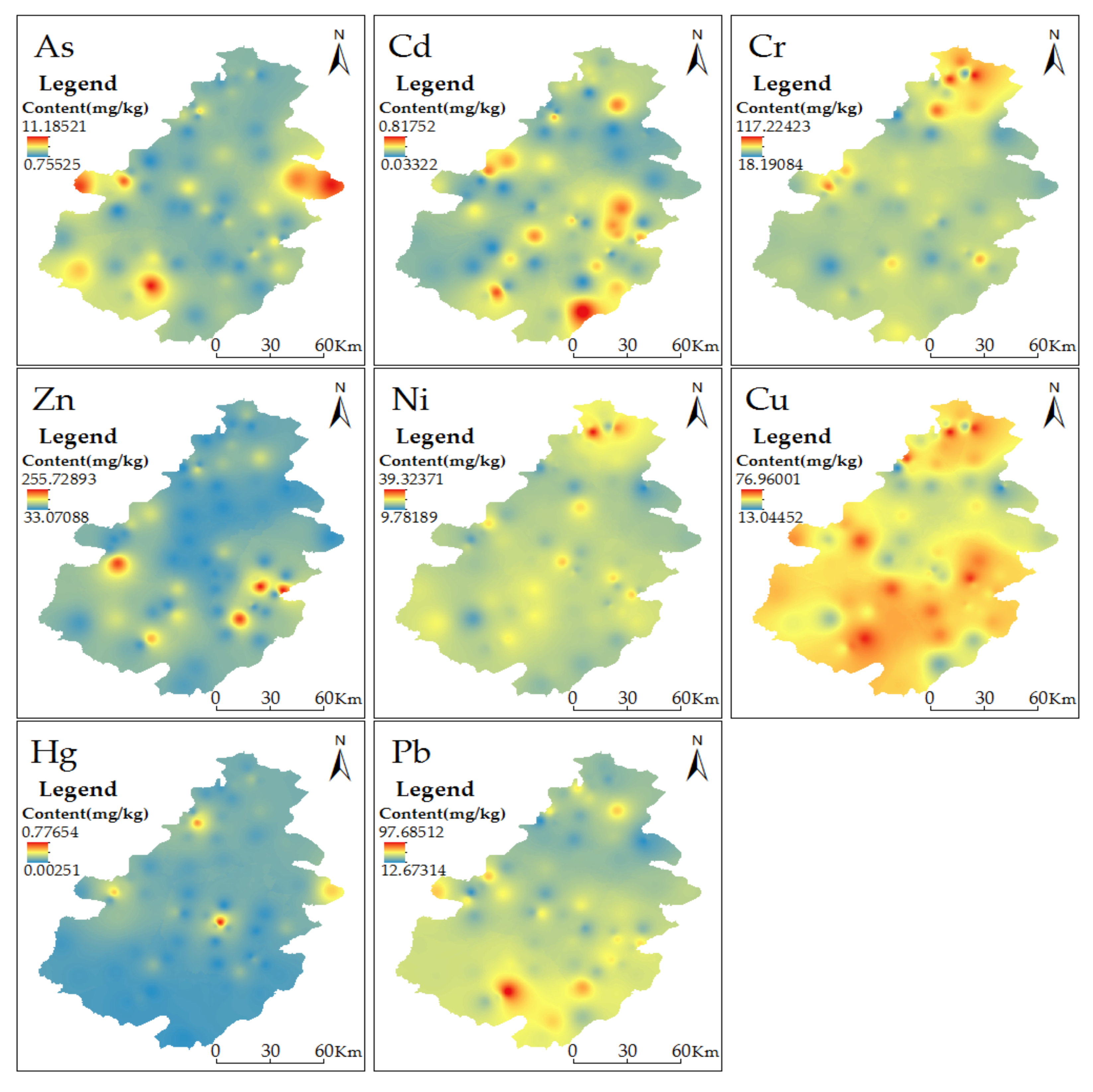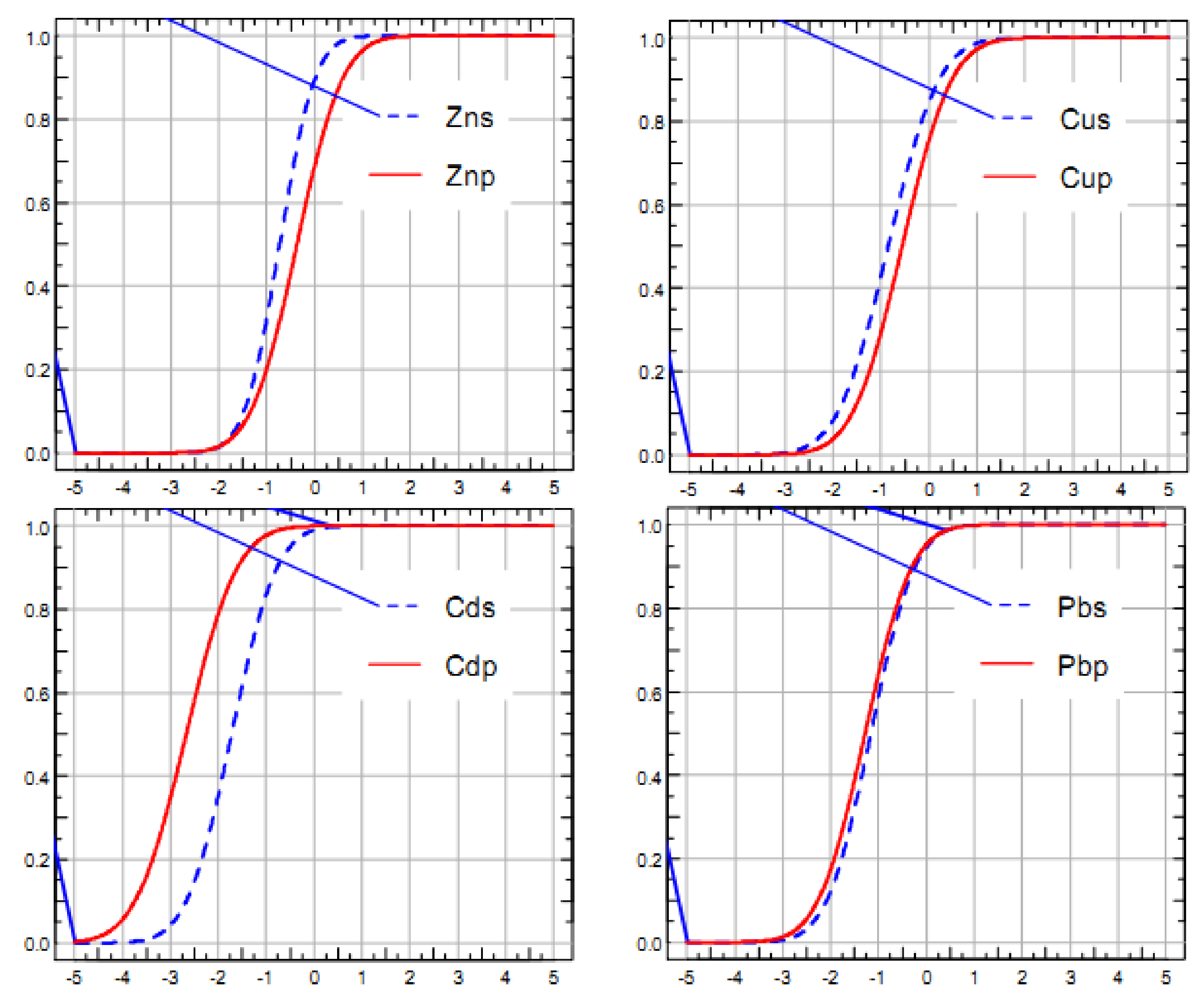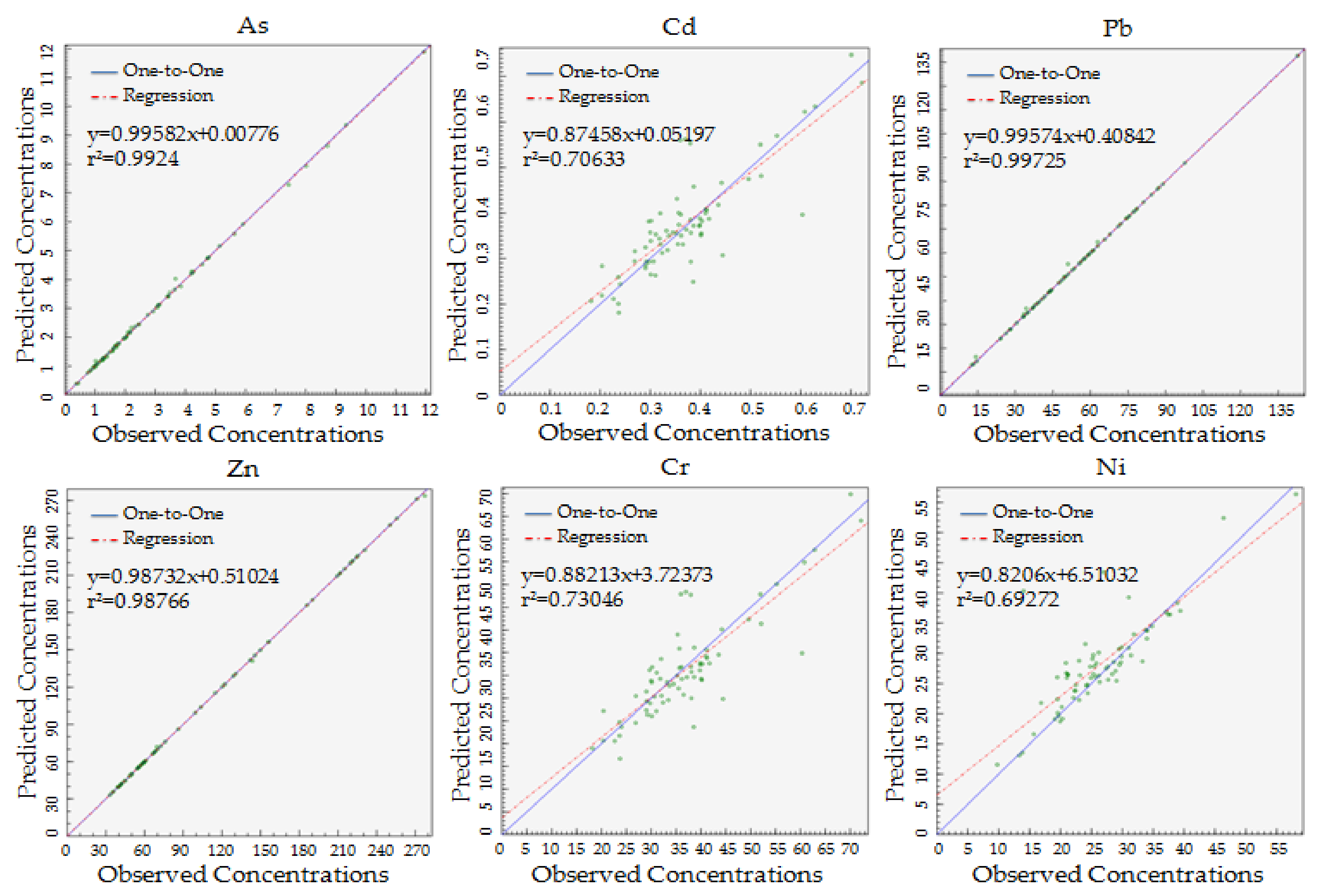Multi-Target Risk Assessment of Potentially Toxic Elements in Farmland Soil Based on the Environment-Ecological-Health Effect
Abstract
:1. Introduction
2. Materials and Methods
2.1. Study Area General Situation
2.2. Sample Collection and Data Source
2.3. Ecological Hazard Assessments of Potentially Toxic Elements in Soil
2.3.1. Potential Ecological Hazard Index Method
2.3.2. Ecological Hazard Quotient Evaluation Method
2.4. Health Hazard Assessments of Potentially Toxic Elements in Soil
2.4.1. Evaluation Model
2.4.2. Hazard Characterization
2.5. PMF Receptor Model
2.6. Statistical Methods
3. Results and Discussion
3.1. Descriptive Statistics of Potentially Toxic Elements Content in Soil
3.2. Assessment of Soil Ecological Hazard in the Study Area
3.2.1. Potential Ecological Hazard Assessment
3.2.2. Ecological Hazard Quotient Evaluation
3.3. Health Risk Assessment and Source Analysis of Potentially Ttoxic Elements in the Study Soil
3.3.1. Health Risk Assessment
3.3.2. Source analysis of Potentially Toxic Elements in Soil
4. Conclusions
- This study only evaluates the total content of PTEs in the soil environment, and an assessment of the available content of PTEs also needs to be considered.
- In this study, the spatial scale of PTEs pollution analysis is large, and it can form the basis for multi-scale and multi-dimension research in further studies.
Author Contributions
Acknowledgments
Conflicts of Interest
References
- Ihedioha, J.N.; Ukoha, P.O.; Ekere, N.R. Ecological and human health risk assessment of heavy metal contamination in soil of a municipal solid waste dump in Uyo, Nigeria. Environ. Geochem. Health 2017, 39, 497–515. [Google Scholar] [CrossRef] [PubMed]
- Adamcová, D.; Vaverková, M.D.; Bartoň, S.; Havlíček, Z.; Břoušková, E. Soil contamination in landfills: A case study of a landfill in Czech Republic. SED 2016, 7, 2927–2952. [Google Scholar] [CrossRef]
- Gworek, B.; Dmuchowski, W.; Koda, E.; Marecka, M.; Baczewska, A.; Brągoszewska, P.; Sieczka, A.; Osiński, P. Impact of the Municipal Solid Waste Łubna Landfill on Environmental Pollution by Heavy Metals. Water-Sui 2016, 8, 470–485. [Google Scholar] [CrossRef]
- Zhao, D.; Wan, S.; Yu, Z.; Huang, J. Distribution, enrichment and sources of heavy metals in surface sediments of Hainan Island rivers, China. Environ. Earth Sci. 2015, 74, 1–14. [Google Scholar] [CrossRef]
- Abrahams, P.W. Soils: Their implications to human health. Sci. Total Environ. 2002, 291, 1–32. [Google Scholar] [CrossRef]
- Sherameti, I.; Varma, A. Soil Heavy Metals. Soil Biol. 2010, 19, 455–456, 978–3-642-02435-1. [Google Scholar]
- Tóth, G.; Hermann, T.; Silva, M.R.; Montanarella, L. Heavy metals in agricultural soils of the European Union with implications for food safety. Environ. Int. 2016, 88, 299–309. [Google Scholar] [CrossRef] [PubMed]
- Papa, S.; Bartoli, G.; Pellegrino, A.; Fioretto, A. Microbial activities and trace element contents in an urban soil. Environ. Monit. Assess. 2010, 165, 193–203. [Google Scholar] [CrossRef] [PubMed]
- U.S. EPA. Exposure Factors Handbook: 2011 Edition; U.S. Environmental Protection Agency: Washington, DC, USA, 2011.
- Olorunfemi, D.I.; Olorunfemi, O.P.; Agbozu, I.E. Genotoxicity Assessment of Contaminated Drinking Water Sources in a Rural Community in Edo State of Nigeria. GEP 2014, 2, 52–59. [Google Scholar] [CrossRef]
- Meena, R.; Datta, S.P.; Golui, D.; Dwivedi, B.S.; Meena, M.C. Long-term impact of sewage irrigation on soil properties and assessing risk in relation to transfer of metals to human food chain. Environ. Sci. Pollut. Res. Int. 2016, 23, 14269–14283. [Google Scholar] [CrossRef] [PubMed]
- Zhao, Z.; Fu, W.; Ye, Z.; Zhang, C. Contamination and Spatial Variation of Heavy Metals in the Soil-Rice System in Nanxun County, Southeastern China. Int. J. Environ. Res. Public Health 2015, 12, 1577–1594. [Google Scholar] [CrossRef] [PubMed]
- Xu, L.; Luo, W.; Lu, Y.; Wang, T.; Chen, C.; Giesy, J.P.; Zhang, Y.; Li, J.; Jorrit, G. Status and fuzzy comprehensive assessment of metals and arsenic contamination in farmland soils along the Yanghe River, China. Chem. Ecol. 2011, 27, 415–426. [Google Scholar] [CrossRef]
- Loska, K.; Wiechuła, D.; Korus, I. Metal contamination of farming soils affected by industry. Environ. Int. 2004, 30, 159–165. [Google Scholar] [CrossRef]
- Lu, S.; Wang, Y.; He, L. Heavy Metal pollution and Ecological Risk Assessment of the Paddy Soils around A Pb-Zn Mine in Huize Country. Ecol. Environ. Sci. 2014, 23, 1832–1838. [Google Scholar]
- Li, L.; Cui, J.; Liu, J.; Gao, J.; Bai, Y.; Shi, X. Extensive study of potential harmful elements (Ag, As, Hg, Sb, Se) in surface sediments of the Bohai Sea, China: Sources and environmental risks. Environ. Pollut. 2016, 219, 432–439. [Google Scholar] [CrossRef] [PubMed]
- Li, Q.; Qin, F.; Ji, H.B. Contents, Sources and Contamination Assessment of Soil Heavy Metals in Gold Mine Area of Upstream Part of Miyun Reservoir, Beijing, China. J. Agro-Environ. Sci. 2013, 32, 2384–2394. [Google Scholar]
- Chen, H.; Teng, Y.; Lu, S.; Wang, Y.; Wang, J. Contamination features and health risk of soil heavy metals in China. Sci. Total Environ. 2015, 512–513, 143–153. [Google Scholar] [CrossRef] [PubMed]
- Ajigul, M.; Mamattursun, E.; Anwar, M.; Mattohti, A. The spatial distribution, contamination, and ecological risk assessment of heavy metals of farmland soils in Karashahar–Baghrash oasis, northwest China. Hum. Ecol. Risk Assess. 2017, 6, 1300–1314. [Google Scholar]
- Qiao, P.W.; Zhou, X.Y.; Yang, J.; Mei, L.; Chen, T.B. Heavy metal pollution and ecological risk assessment of Datun basin in the Gejiutinmining area, Yunnan Province. Geol. Bull. China 2014, 33, 1253–1259. [Google Scholar]
- Jian-Hua, M.A.; Wang, X.Y.; Hou, Q.; Duan, H.J. Pollution and potential ecological risk of heavy metals in surface dust on urban kindergartens. Geogr. Res. 2011, 30, 486–495. [Google Scholar]
- Li, Z.; Ma, Z.; Kuijp, T.J.V.D.; Yuan, Z.; Huang, L. A review of soil heavy metal pollution from mines in China: Pollution and health risk assessment. Sci. Total Environ. 2014, 468–469, 843–853. [Google Scholar] [CrossRef] [PubMed]
- Hu, Y.; Liu, X.; Bai, J.; Shih, K.; Zeng, E.Y.; Cheng, H. Assessing heavy metal pollution in the surface soils of a region that had undergone three decades of intense industrialization and urbanization. Environ. Sci. Pollut. Res. 2013, 20, 6150–6159. [Google Scholar] [CrossRef] [PubMed]
- Cui, X.T.; Luan, W.L.; Shi, S.J.; Sui-Min, L.I.; Song, Z.F.; Zhong-She, M.A. Soil heavy metal pollution assessment in the sewage irrigation region of Shijiazhuang City. Environ. Earth 2010, 38, 36–42. [Google Scholar]
- Lv, J.; Liu, Y.; Zhang, Z.; Dai, J.; Dai, B.; Zhu, Y. Identifying the origins and spatial distributions of heavy metals in soils of Ju country (Eastern China) using multivariate and geostatistical approach. J. Soils Sediments 2015, 15, 163–178. [Google Scholar] [CrossRef]
- U.S. EPA. Risk Assessment Guidance for Superfund Volume I Human Health Evaluation Manual (Part A); EPA/540/1-89/002; U.S. EPA: Washington, DC, USA, 1989; pp. 35–52.
- Hakanson, L. An ecological risk index for aquatic pollution control. A sedimentological approach. Water Res. 1980, 14, 975–1001. [Google Scholar] [CrossRef]
- HJ/T 166-2004. The Technical Specification for Soil Environmental Monitoring; Ministry of Ecology and Environment of the People’s Republic of China: Beijing, China, 2004.
- Fernández, J.A.; Carballeira, A. Evaluation of contamination, by different elements, in terrestrial mosses. Arch. Environ. Contam. Toxicol. 2001, 40, 461–468. [Google Scholar] [PubMed]
- Chen, Y.X.; Jiang, X.S.; Yong, W.; Zhuang, D.F. Assessment of ecological environment and human health of heavy metals in mining area based on GIS. J. Agro-Environ. Sci. 2018, 38, 1642–1652. [Google Scholar]
- Zhi, B.L.; Yongming, L.; Jing, S.; Qiguo, Z.; Zhiquan, L. Soil environmental quality guidance and standard research II. Acta Pedol. Sin. 2006, 1, 142–152. [Google Scholar]
- Zhao, L.; Xu, Y.; Hou, H.; Shang, Y.; Li, F. Source identification and health risk assessment of metals in urban soils around the Tanggu chemical industrial district, Tianjin, China. Sci. Total Environ. 2014, 468–469, 654–662. [Google Scholar] [CrossRef] [PubMed]
- Wu, S.; Peng, S.; Zhang, X.; Wu, D.; Luo, W.; Zhang, T.; Zhou, S.; Yang, G.; Wan, H.; Wu, L. Levels and health risk assessments of heavy metals in urban soils in Dongguan, China. J. Geochem. Explor. 2015, 148, 71–78. [Google Scholar] [CrossRef]
- Wang, Y.; Yang, L.; Kong, L.; Liu, E.; Wang, L.; Zhu, J. Spatial distribution, ecological risk assessment and source identification for heavy metals in surface sediments from Dongping Lake, Shandong, East China. CATENA 2015, 125, 200–205. [Google Scholar] [CrossRef]
- Azpurua, M.A.; Ramos, K.D. A Comparison of Spatial Interpolation Methods for Estimation of Average Electromagnetic Field Magnitude. Prog. Electromagn. Res. 2010, 14, 135–145. [Google Scholar] [CrossRef]
- Rodríguez-Seijo, A.; Andrade, M.L.; Vega, F.A. Origin and spatial distribution of metals in urban soils. J. Soils Sediments 2015, 17, 1–13. [Google Scholar] [CrossRef]
- Puskás, I.; Farsang, A. Diagnostic indicators for characterizing urban soils of Szeged, Hungary. Geoderma 2009, 148, 267–281. [Google Scholar] [CrossRef]
- Zechmeister, H.G.; Hohenwallner, D.; Riss, A.; Hanus-Illnar, A. Estimation of element deposition derived from road traffic sources by using mosses. Environ. Pollut. 2005, 138, 238. [Google Scholar] [CrossRef] [PubMed]
- Fernández-Espinosa, A.J.; Ternerorod-Ríguez, M. Study of traffic pollution by metals in Seville (Spain) by physical and chemical speciation methods. Anal. Bioanal. Chem. 2004, 379, 684–699. [Google Scholar] [CrossRef] [PubMed]
- Müller, G. Schwermetalle in den sedimenten des Rheins-Veräderungen seit. Umschau Wissens Chaft Und Tech. 1979, 79, 778–783. [Google Scholar]
- Żukowska, J.; Biziuk, M. Methodological evaluation of method for dietary heavy metal intake. Food Sci. 2008, 73, R21–R29. [Google Scholar] [CrossRef] [PubMed]




| Parameter | Ecology Hazard | Slight | Intermediate | Strongly | Strongly–Extremely | Extremely |
|---|---|---|---|---|---|---|
| Hakanson | <40 | 40–80 | 80–160 | 160–320 | ≥320 | |
| RI | <150 | 150–300 | 300–600 | ≥600 | - | |
| This research | <40 | 40–80 | 80–160 | 160–320 | ≥320 | |
| RI | <46 | 46–92 | 92–184 | ≥184 | - |
| Factor | Meaning | Value | Factor | Meaning | Value |
|---|---|---|---|---|---|
| IngR | Uptake of soil rate, mg/d | 200 | BW | Children’s weight, kg | 16 |
| InhR | Respiratory intake, m3/d | 7.5 | AT | Mean time of action, d | 365 × 10 |
| ABS | Skin absorption factor | 0.001 | FSPO | The proportion of soil particles in the air | 0.5 |
| EF | Exposed frequency, d/a | 365 | PLAF | Retention ratio | 0.75 |
| ED | Exposed year, a | 10 | PM10 | Inhalable content, mg/m3 | 0.3 |
| SA | Expose skin surface area, cm2 | 1600 | SL | Adhesiveness of skin, mg·cm−2/d | 0.2 |
| c | Concentration, mg/kg | - | CF | Conversion fraction | 1 × 10−6 |
| Element | RfD (mg/kg d) | ||
|---|---|---|---|
| Soil Uptake | Respiratory Inhalation | Skin Absorption | |
| Cd | 0.1 × 10−2 | 0.1 × 10−2 | 0.1 × 10−2 |
| Cu | 0.038 | 0.012 | 0.038 |
| Zn | 0.3 | 0.3 | 0.3 |
| Pb | 3.5 × 10−3 | 0.525 × 10−3 | 0.352 × 10−3 |
| Element | Range | Mean | Standard 1 | Background | Muller Index | Formula |
|---|---|---|---|---|---|---|
| As | 0.76–11.19 | 5.32 | 30 | 12.87 | −2.19 | Inside; Ci means Elemental concentration (mg/kg); Bi means Background value (mg/kg); K = 1.5. |
| Cd | 0.03–0.82 | 0.31 | 0.6 | 0.07 | 1.27 | |
| Cr | 18.1–117.2 | 50.44 | 250 | 64.33 | −1.04 | |
| Cu | 13.4–76.9 | 47.05 | 100 | 22.33 | 0.34 | |
| Hg | 0.003–0.77 | 0.025 | 3.4 | 0.02 | −0.71 | |
| Zn | 33.1–255.7 | 79.36 | 300 | 64.01 | −0.42 | |
| Ni | 9.78–39.32 | 26.01 | 190 | 28.68 | −0.78 | |
| Pb | 12.67–97.69 | 35.65 | 170 | 20.98 | −0.05 | |
| pH | 7.02–8.73 | 8.06 | - | - | - |
| Parameter | Element | Toxic Parameters | Standard Value | |||
|---|---|---|---|---|---|---|
| Hazard Index | Average | Ranking | ||||
| Cd | 30 | 0.6 | 1.66–40.88 | 15.75 | Slight | |
| Cu | 5 | 100 | 0.65–3.85 | 2.35 | ||
| Zn | 1 | 300 | 0.11–0.88 | 0.27 | ||
| Pb | 5 | 170 | 0.32–2.87 | 1.07 | ||
| RI | 5.2–44.95 | 19.44 | Slight |
| Parameter | Soil Uptake | Respiratory Inhalation | Skin Absorption | Total Risk HQ |
|---|---|---|---|---|
| Cd | 3.86 × 10−3 | 1.63 × 10−5 | 6.17 × 10−6 | 3.88 × 10−3 |
| Cu | 1.55 × 10−2 | 2.07 × 10−4 | 2.48 × 10−5 | 1.57 × 10−2 |
| Zn | 3.31 × 10−3 | 1.39 × 10−5 | 5.29 × 10−6 | 3.33 × 10−3 |
| Pb | 1.27 × 10−1 | 3.58 × 10−3 | 2.02 × 10−3 | 1.32 × 10−1 |
| HI | 1.56 × 10−1 |
| Element | Source Profile (mg/kg) | Source Contribution (%) | ||||||
|---|---|---|---|---|---|---|---|---|
| Factor 1 | Factor 2 | Factor 3 | Factor 4 | Factor 1 | Factor 2 | Factor 3 | Factor 4 | |
| As | 1.29 | 0.21 | 0.86 | 3.57 | 15.43 | 8.11 | 9.2 | 67.26 |
| Cd | 0.04 | 0.13 | 0.001 | 0.09 | 15.72 | 45.19 | 7.24 | 31.85 |
| Cr | 3.95 | 8.13 | 11.1 | 39.7 | 4.47 | 7.33 | 14.71 | 73.49 |
| Cu | 9.91 | 10.7 | 7.49 | 19.32 | 21.48 | 27.5 | 16.9 | 34.12 |
| Pb | 4.43 | 9.33 | 6.45 | 7.61 | 18.14 | 33.82 | 21.63 | 26.41 |
| Zn | 7.25 | 21.83 | 13.47 | 18.23 | 12.47 | 36.71 | 23.9 | 26.92 |
| Ni | 1.26 | 3.54 | 7.87 | 13.33 | 4.32 | 18.68 | 35.73 | 41.27 |
© 2018 by the authors. Licensee MDPI, Basel, Switzerland. This article is an open access article distributed under the terms and conditions of the Creative Commons Attribution (CC BY) license (http://creativecommons.org/licenses/by/4.0/).
Share and Cite
Wang, Z.; Meng, B.; Zhang, W.; Bai, J.; Ma, Y.; Liu, M. Multi-Target Risk Assessment of Potentially Toxic Elements in Farmland Soil Based on the Environment-Ecological-Health Effect. Int. J. Environ. Res. Public Health 2018, 15, 1101. https://doi.org/10.3390/ijerph15061101
Wang Z, Meng B, Zhang W, Bai J, Ma Y, Liu M. Multi-Target Risk Assessment of Potentially Toxic Elements in Farmland Soil Based on the Environment-Ecological-Health Effect. International Journal of Environmental Research and Public Health. 2018; 15(6):1101. https://doi.org/10.3390/ijerph15061101
Chicago/Turabian StyleWang, Zhongyang, Bo Meng, Wei Zhang, Jinheng Bai, Yingxin Ma, and Mingda Liu. 2018. "Multi-Target Risk Assessment of Potentially Toxic Elements in Farmland Soil Based on the Environment-Ecological-Health Effect" International Journal of Environmental Research and Public Health 15, no. 6: 1101. https://doi.org/10.3390/ijerph15061101
APA StyleWang, Z., Meng, B., Zhang, W., Bai, J., Ma, Y., & Liu, M. (2018). Multi-Target Risk Assessment of Potentially Toxic Elements in Farmland Soil Based on the Environment-Ecological-Health Effect. International Journal of Environmental Research and Public Health, 15(6), 1101. https://doi.org/10.3390/ijerph15061101





